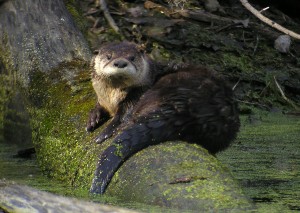River Otter
River Otter: Photo Credit: River Otter Academy
The River otter (Lontra Canadensis) is a semiaquatic mammal in the weasel family. Its head is flattened with small ears. It has short legs with webbed toes, and a tapered tail designed for swimming nearly 7miles per hour. The fur on its back consists of a soft oily underfur interspersed with longer glossy guard hairs. River otters construct dens under tree roots, in thickets, in burrows abandoned by woodchucks as well as abandoned beaver & muskrat lodges. In the 1800s and earlier, River otters lived along all major rivers and numerous permanent streams across Kansas. However, overtrapping and agricultural development of land along water habitat severely reduced river otter population throughout the Great Plains and much of the Midwest so that River otters were extirpated in Kansas by 1904. However, in 1983 and 1984, 19 river otters from Idaho and Massachusetts were reintroduced on the South Fork Cottonwood River in Chase County. Also, multiple reintroductions of River otters from Missouri established a large population of otters by the year 2000. Today, river otters live in eastern Kansas along portions of the Cottonwood, Neosho, Spring, Marmaton, Marais de Cynes, Deleware, Kansas, and Missouri rivers. Although mostly active after sundown, river otters may be observed during daylight hours also. They forage along streams and rivers mostly for nongame fish and crayfish depending upon the time of year. When opportunity provides it River otters will consume various fruits, voles, deer mice, muskrats, young beavers, reptiles, birds, bird eggs, frogs, crayfish, molluscs, large insects and worms. They are susceptible to water pollution since they accumulate mercury and other toxins. The Clean Water Act has reduced pollution of the large rivers but small wetlands and stream are still vulnerable to polluters.

